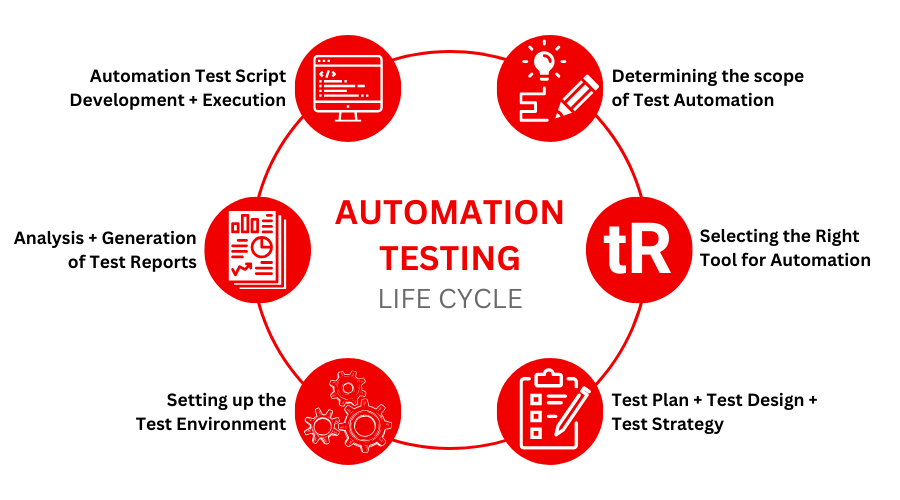Automation Testing: Trick Tips to Improve Advancement Lifecycles
Automation Testing: Trick Tips to Improve Advancement Lifecycles
Blog Article
From Handbook to Automated Testing: A Comprehensive Overview to Transitioning Efficiently and Effectively
In the realm of software application testing, the change from handbook to automated processes has actually ended up being a progressively vital change for companies seeking to improve effectiveness and precision in their screening methods. As innovation remains to breakthrough, the requirement for seamless and reliable automated screening methods has actually never been a lot more pressing. The trip from guidebook to automated screening is not without its challenges, yet when approached tactically and with a clear plan in mind, the advantages can be considerable - automation testing. In this detailed overview, we will certainly check out essential actions and considerations essential for an effective shift, from the preliminary choice of tools to the integration of automation right into existing workflows. Remain tuned to reveal the insights that will assist lead the way for a smoother and a lot more effective screening process.
Benefits of Automated Evaluating
Automated screening offers many advantages, improving performance and precision in software program development procedures. Automated tests can be run simultaneously on numerous devices and operating systems, considerably speeding up the testing phase contrasted to manual screening.
Moreover, automated testing guarantees a higher degree of accuracy in finding problems. Since automated tests follow predefined scripts, human mistake is lessened, resulting in more reliable examination results. Uniformity in screening is also boosted, as automated tests execute the same actions specifically each time they are run. This uniformity is essential in ensuring that all functionalities of the software application are thoroughly checked, minimizing the likelihood of unseen pests sliding with to manufacturing.
Selecting the Right Devices

First of all, examine your demands and purposes. Comprehend the scope of your job, the technologies entailed, and the capability of your group. This analysis will assist you determine the features and abilities you call for in your testing devices.
Secondly, take into consideration the compatibility of the tools with your existing procedures and systems. Smooth assimilation with your existing software program growth lifecycle is vital to make sure a smooth shift to automation.
Furthermore, evaluate the scalability and adaptability of the tools. As your testing needs develop, the devices must have the ability to adapt and accommodate changes effectively.
Finally, factor in the assistance and neighborhood around the tools. When implementing automated testing, durable support and an energetic customer neighborhood can provide valuable sources and help. By thoroughly taking into consideration these aspects, you can pick the right devices that align with your requirements and set the stage for an effective change to automated screening.
Composing Efficient Test Scripts

When crafting test manuscripts, it is important to think about the certain demands of the software application being examined and make sure that the scripts resolve all important functionalities. Clear and detailed calling conventions for test manuscripts and examination cases can boost readability and maintainability. Furthermore, including error handling devices within the test manuscripts can help in recognizing and dealing with concerns quickly.
Furthermore, arranging examination scripts into modular components can boost reusability and scalability, lowering redundancy and enhancing effectiveness in examination manuscript maintenance. Normal testimonials and updates to evaluate scripts are vital to keep speed with developing software application needs and capabilities. By adhering to these their website principles, testers can create robust and efficient test scripts that add dramatically to the success of automated screening procedures.
Integrating Automation Into Workflows
Effective combination of automation tools into existing operations improves processes and enhances performance within software growth cycles. When including automation into workflows, it is crucial to identify recurring jobs that can be automated to conserve time and reduce human mistake. By flawlessly integrating automated testing devices like Selenium or Appium into the software application growth lifecycle, teams can attain faster responses on code changes, bring about quicker insect discovery and resolution. This integration enables constant testing throughout the development process, making sure that any type of issues are recognized early, resulting in greater software application high quality. Furthermore, automation can be made use of to cause examinations automatically after each code devote, offering prompt recognition and maximizing testers to concentrate on more facility situations. Appropriate integration of automation tools needs partnership between development, screening, and operations groups to establish a unified workflow that maximizes effectiveness and efficiency in providing high-grade software.
Making Certain a Smooth Transition
Successfully transitioning to automated screening involves meticulous preparation and cautious implementation to reduce interruptions and take full advantage of performance in the software application advancement procedure - automation testing. To make sure a smooth change, it is important to begin by performing a thorough analysis of the current testing processes and determining locations where automation can bring the most considerable benefits. Engaging with all stakeholders early at the same time, including developers, testers, and job supervisors, is critical for amassing assistance and buy-in for the automation initiative
Interaction is key during this transition stage. Clear interaction of the objectives, benefits, and assumptions of automated testing helps to handle any kind of resistance or concerns that might occur. Additionally, giving appropriate training and sources for staff member to upskill in automation devices and methods is important for ensuring an effective transition.

Conclusion
Finally, transitioning from guidebook to automated screening uses various benefits, including enhanced effectiveness and dependability. By choosing the appropriate tools, creating effective test manuscripts, and integrating automation perfectly into process, organizations can make sure a smooth and successful transition. It is necessary to embrace automation click to read more as a beneficial asset in software testing procedures to improve overall high quality and productivity.
In the world of software application screening, the change from manual to automated procedures has ended up being a progressively crucial change for companies looking for to boost efficiency and precision in find more information their screening practices. Automated tests can be run all at once on numerous gadgets and running systems, considerably speeding up the testing stage contrasted to manual testing. Uniformity in screening is also improved, as automated tests implement the same actions exactly each time they are run.To make certain the successful execution of selected screening devices, the development of reliable test manuscripts plays an important duty in confirming the functionality and efficiency of automated procedures - automation testing. By complying with these principles, testers can develop durable and reliable examination manuscripts that add substantially to the success of automated screening processes
Report this page